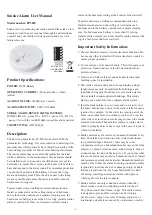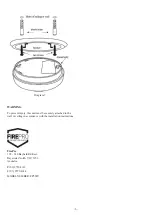
CAUTION: Due to the loudness (85 decibels) of the alarm,
always stand an arms-length always from the unit when
testing
Test the alarm weekly to ensure proper operation. Erratic or
low sound coming from your alarm may indicate a defective
alarm
NOTE: WEEKLY TESTING IS REQUIRED.
LED indicators
This alarm is equipped with a red LED indicator, with two
modes of operation.
Red LED-Flashing every 32 seconds: indicates that the smoke
alarm is operating properly.
RED LED-Flashing: when the Test button is pressed, or when
the smoke alarm sense particles of combustion and goes into
alarm (constant pulsating sound), the red LED will flash
once per second. The flashing LED and pulsating alarm will
continue until the air is cleared
Fault indication - The unit will generate a “chirp” between
two flashes every 32 seconds when the unit goes into fault
mode.
NOTE: WEEKLY TESTING IS REQUIRED.
DANGER: If the alarm sounds, and it is not being tested, it
means the unit is sensing smoke, THE SOUND OF THE
ALARM REQUIRES YOUR IMMEDIATE ATTENTION
AND ACTION.
Maintenance and Cleaning:
In addition to weekly testing, the alarm requires yearly battery
replacement and periodic cleaning to remove dust, dirt, and
debris.
Clean the alarm at least once a month to remove dust, dirt, or
debris. Always turn off power before cleaning.
Use a vacuum cleaner with the soft brush, vacuum all sides
and covers of smoke alarm. Be sure all the vents are free of
debris. Use a damp cloth to clean the alarm’s cover.
This smoke alarm uses a 9 volt battery. A fresh battery should
last for one year under normal operating conditions.
This alarm has a low battery monitor which will cause the
alarm to “chirp” and at the same time as the red LED flash
approx every 32 seconds for a minimum of seven days when
the battery gets low. Replace the battery when this condition
occurs. Please refer to “REPLACE BATTERY”.
IMPORTANT: Do not attempt to remove the cover to clean
inside. This will affect warranty.
Repair:
Caution: Do not attempt to repair the alarm. It will affect your
warranty.
If the alarm is not operating properly, and is still under
warranty, return it to the original place you purchased it from.
Pack it in a well-padded carton, and ship to the original place
of purchase.
If the alarm is out of warranty, replace it immediately with a
comparable alarm.
Practice Fire Safety:
If the alarm sounds, and you have not pushed the test button,
it is warning of a dangerous situation, your immediate
response is necessary. To prepare for such occurrences,
develop family escape plans, discuss them with all household
members, and practice them regularly.
1: Expose everyone to the sound of a smoke alarm and
explain what the sound means.
2: Determine two exits from each room and an escape route to
the outside from each exit.
3: Teach all household members to touch the door and use
an alternate exit when the door is hot, instruct them not to
open the door if the door is hot.
4: Teach household members to crawl along the floor to stay
below dangerous smoke, fumes and gases.
5: Determine a safe meeting place for all members outside the
building.
What to Do in Case of Fire:
1: Do not be panic; stay calm.
2: Leave the building as quickly as possible. Touch doors to
feel if they were hot before opening them. Use an alternate
exit if necessary. Crawl along the floor, and don’t stop to
collect anything.
3: Meet at a pre-arranged meeting place outside the building.
4: Call the fire department form outside the building.
5: Do not go back inside a burning building. Wait for the fire
department to arrive.
Note: These guidelines will assist you in the event of a fire,
however, to reduce the chance that fires will start, practice fire
safety rules and prevent hazardous situations.
- 3 -






